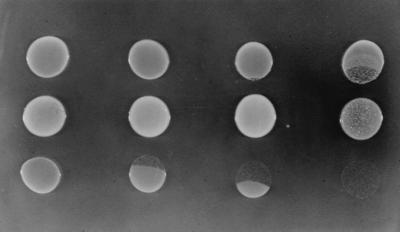FIG. 6.

Detection of extracellular protocatechuate generated by mutant strains growing in the presence of quinate. A 20-μl aliquot of an LB culture of each strain was spotted onto a plate with 10 mM succinate and 5 mM quinate and incubated overnight at 37°C. In the top and bottom rows are cells of ADP603 (Δqui1 ΔpcaBDK1) added simultaneously (top row) or 5 h after (bottom row) strains in the middle row (from left to right): ADP1 (wild type), ADP859 (ΔpcaK859), ADP7618 (ΔvanK1103), and ADP7577 (ΔpcaK859 ΔvanK1103). Deletion of quinate genes in ADP603 prevents the toxic accumulation of carboxymuconate during growth of this strain in the presence of quinate but not protocatechuate (Fig. 1). Growth of ADP603 can therefore serve as a detector of protocatechuate diffusing from adjacent cells of mutant strains impaired to various degrees in transport of protocatechuate across the inner cell membrane after its generation from quinate in the periplasm (Fig. 5). The speckling observed in the spot of ADP7577 cells is due to reversion of ΔvanK1103.
